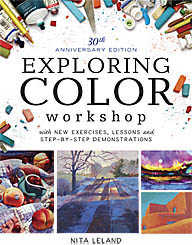Painting Shadows
Yesterday's watercolor class was a brief course in light and shadow. I showed them the text and diagrams on pp. 114-116 in Exploring Color . These pages describe how shadows are a translucent veil that allows the color underneath to show through. Shadows can be a neutral gray color, cool blue or violet, or a warm color suggesting the bouncing sunlight. Next we looked at pp. 68-69 in The New Creative Artist which include definitions of qualities of light from highlight through shade, reflected light and shadow.
Then I talked about perspective in shadows and how they are harder-edged and darker at the base of the object and become gradually softer and lighter in value as they move away from it. I stressed the importance of establishing at the start where the light is coming from. In plein air this involves careful observation and being aware that the light is changing as you work. You can paint your shadow pattern first in neutral monochrome and then glaze the colors on top. If you're working from photographs or sketches, careful observation is equally important. And if you're changing the light source, you must be constantly aware of how that affects every aspect of the subject. We also talked briefly about how shadows help to describe the surface of a subject, where hard edges suggest corners and soft edges indicate soft contours. This is true of any subject from figures to landscape. Shadows are key to the illusion of reality in your picture.
Then I talked about perspective in shadows and how they are harder-edged and darker at the base of the object and become gradually softer and lighter in value as they move away from it. I stressed the importance of establishing at the start where the light is coming from. In plein air this involves careful observation and being aware that the light is changing as you work. You can paint your shadow pattern first in neutral monochrome and then glaze the colors on top. If you're working from photographs or sketches, careful observation is equally important. And if you're changing the light source, you must be constantly aware of how that affects every aspect of the subject. We also talked briefly about how shadows help to describe the surface of a subject, where hard edges suggest corners and soft edges indicate soft contours. This is true of any subject from figures to landscape. Shadows are key to the illusion of reality in your picture.
Labels: creative artist, exploring color, landscape, perspective, still life, tutorials, value, watercolor techniques





0 Comments:
Post a Comment
<< Home